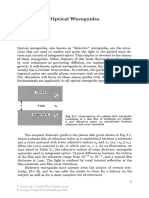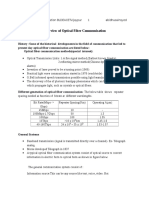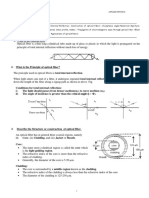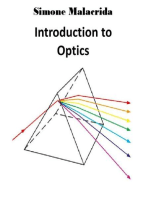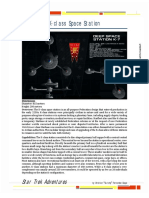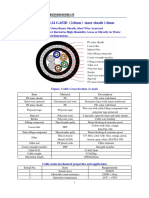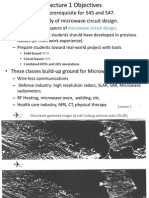For Mate
For Mate
Uploaded by
yash parmarCopyright:
Available Formats
For Mate
For Mate
Uploaded by
yash parmarOriginal Description:
Copyright
Available Formats
Share this document
Did you find this document useful?
Is this content inappropriate?
Copyright:
Available Formats
For Mate
For Mate
Uploaded by
yash parmarCopyright:
Available Formats
ELECTRONICS AND COMMUICATION
SEMESTER : 6th _BATCH_B3
ENROLLMENT NO._ 210210111501
GOVERNMENT ENGINEERING COLLAGE
BHAVNAGAR-364002
EXPERIMENT : 2
AIM : - To write scilab code for given example of optical Fiber Waveguide.
SOFTWARE:- Scilab 6.1.0
THEORY :
What is Optical Fiber ?
An optical fiber is a hair thin cylindrical fiber of glass or any transparent dielectric
medium. The fiber which are used for optical communication are wave guides made
of transparent dielectrics. Its function is to guide visible and infrared light over long
distance.
What is Waveguide?
A Hollow metallic tube of uniform cross section for transmitting
electromagnetic waves by successive reflections from the inner walls of the tube is
calls waveguide.
Waveguides may be used to carry energy between pieces of equipment or over longer
distances to carry transmitter power to an antenna or microwave signals from an
antenna to a receiver.
Waveguides are made from copper, aluminium. These metals are extruded into long
rectangular or circular pipes.
An electromagnetic energy to be carried by a waveguide is injected into one end of
the waveguide. The electric and magnetic fields associated with the signal bounce off
the inside walls back and forth as it progresses down the waveguide.
Reflection:
In simple terms, reflection implies the rebounding of light, sound, heat or
another object back to the source, without absorbing it. It alters the direction of the
beam of light, when it falls on the plane, amidst two media, so that the ray goes back
to the medium, in which it is generated. The law of reflection says:
1. The angle of incidence is identical to the angle of reflection.
2. The ray of incidence, ray of reflection and the normal drawn at the point of
incidence, to the mirror, occurs at the same plane.
FACULTY NAME : PROF._JANAK TRIVEDI
SUBJECT :_ FIBER OPTIC CIMMUNICATION(3161005)
ELECTRONICS AND COMMUICATION
SEMESTER : 6th _BATCH_B3
ENROLLMENT NO._ 210210111501
GOVERNMENT ENGINEERING COLLAGE
BHAVNAGAR-364002
These two principles are apposite to all kinds of reflecting planes. Reflection can be of
two types:
Regular reflection: Otherwise known as specular reflection, which occurs
when the beam of light falls on a regular, polished and smooth plane, such as
metal or mirror, reflects light at the same angle as it is incident to the surface.
Irregular reflection: Also called as diffused reflection, which takes place
when the beam of light is incident on the rough surface and reflects light in
diverse directions
Refraction:
Refraction can be understood as the phenomenon of light, wherein the wave is
diverted when it passes diagonally through the interface between two media of
different densities. It refers to the shift in direction and speed of the beam of light or
radio waves, because of the change in transmission medium.
Refractive index is the ratio of the angle of incidence to the angle of refraction. It
ascertains the speed of a ray of light in the new medium, i.e. the denser the medium the
slow is the speed of light, and vice versa.
Refraction index = n=C/V _______________________(2.1)
= speed of light in free space / velocity of light in non-conducting medium.
Fig_(A)2.1 Reflaction
FACULTY NAME : PROF._JANAK TRIVEDI
SUBJECT :_ FIBER OPTIC CIMMUNICATION(3161005)
ELECTRONICS AND COMMUICATION
SEMESTER : 6th _BATCH_B3
ENROLLMENT NO._ 210210111501
GOVERNMENT ENGINEERING COLLAGE
BHAVNAGAR-364002
Snell’s law: “The ratio of the sine of the angle of incidence to the sine of the angle of
refraction is a constant, for the light of a given color and for the given pair of media”.
Snell’s law formula is expressed as:
n1 sinΦ1= n2 sinΦ2
_______________(2.2)
Total Internal Reflection:
A ray of light passes from a medium of water to that of air. Light ray will be refracted
at the junction separating the two media. Since it passes from a medium of a higher
refractive index to that having a lower refractive index, the refracted light ray bends
away from the normal.
At a specific angle of incidence, the incident ray of light is refracted in such a way
that it passes along the surface of the water. This particular angle of incidence is
called the critical angle. Here the angle of refraction is 90 degrees.
Critical angle(Φ)= sin Φ = n2/n1 ______________
(2.3)
When the angle of incidence is greater than the critical angle, the incident ray is
reflected back to the medium. We call this phenomenon total internal reflection.
Figure(B)2.2_Total internal reflaction
FACULTY NAME : PROF._JANAK TRIVEDI
SUBJECT :_ FIBER OPTIC CIMMUNICATION(3161005)
ELECTRONICS AND COMMUICATION
SEMESTER : 6th _BATCH_B3
ENROLLMENT NO._ 210210111501
GOVERNMENT ENGINEERING COLLAGE
BHAVNAGAR-364002
Acceptance angle and numerical aperture :
The acceptance angle is a function of the refractive indices of the core and the
cladding materials.
Acceptance angle (θa ) = sin-1NA
___________________(2.4)
The sine of the acceptance angle is called the numerical aperture. The
numerical aperture (NA) of an optical system is a dimensionless number that
characterizes te range of angles over which the system can accept or emit light.
NA = n1(2∆)1/2 Where, ∆ = (n12-n22)/2n11
___________________(2.5)
For small angles the solid acceptance angle in air ζ is given by;
ζ = πθa2 = π sin2θa
___________________(2.6)
The acceptance angle for skew rays is : θas = sin-1(NA)/cos λ)
_____________(2.7)
Normalized frequency:
Also referred to as the V number in fiber optics; the normalized frequency is a
dimensionless quantity, denoted by the symbol V, given by:
2 πa 2
V¿
λ
√ 2
n 1+n 2 ____________________(2.8)
where a is waveguide core radius, 1 is wavelength in vacuum, and nl and n2 are the
maximum
refractive index in the core and refractive index of the homogeneous cladding,
respectively.
(Note that the difference between the square root of the squares of nl and n2is by
definition the numérical aperture of the fiber.)
For a multimode fiber, the mode volume of that fiber, which is the approximate
number of bound modes within that fiber is directionally proportional to the
normalized frequency.
FACULTY NAME : PROF._JANAK TRIVEDI
SUBJECT :_ FIBER OPTIC CIMMUNICATION(3161005)
ELECTRONICS AND COMMUICATION
SEMESTER : 6th _BATCH_B3
ENROLLMENT NO._ 210210111501
GOVERNMENT ENGINEERING COLLAGE
BHAVNAGAR-364002
For a single –mode fiber , it is requied that the normalized frequency, satisfies the
condition V< 2. 4048. For a step index fiber, the mode volume of that fiber is
directionally proportional to the square of the normalized frequency, that is V2.
Number of Modes traveling in Fiber:
The total number of traveling in a fiber depends on the V – Number and is related as:
For Step Index Fiber
2
V
N=
2
__________________(2.9)
For Graded Index fiber
V2
N=
4
________________(2.10)
Question:1 A silica optical fiber with a core diameter large enough to be considered
by ray theory analysis has a core refractive index of 1.50 and a cladding refractive
index of 1.47. Determine: (a) the critical angle at the core–cladding interface; (b) the
NA for the fiber; (c) the acceptance angle in air for the fiber.
Code:
//As per Given data 1: n1,n2 is given, Find Critical Angle, NA, and Accepance
Angle ?
n1 = 1.50 ; //Core refractive index
n2 = 1.47; //Cladding refractive index
PHIc = asin(n2/n1)*180/%pi; // Critical Angle at the core-cladding interface in
degree
NA = sqrt(n1*n1-n2*n2); // NA for the fiber
THEETAa = asin(NA)*180/%pi; // Accepance Angle in air for the fiber in
Degrees
//Displaying The Results
FACULTY NAME : PROF._JANAK TRIVEDI
SUBJECT :_ FIBER OPTIC CIMMUNICATION(3161005)
ELECTRONICS AND COMMUICATION
SEMESTER : 6th _BATCH_B3
ENROLLMENT NO._ 210210111501
GOVERNMENT ENGINEERING COLLAGE
BHAVNAGAR-364002
Printf(“\n\t Critical Angle at the core-cladding interface is %0.1f degrees.”,PHIc);
Printf(“\n\t NA for the fiber is %0.2f “, NA);
Printf(“\n\t Accepance Angle in air for the fiber is %0.1f degrees”, THEETAa);
Result:
Question:2 A typical relative refractive index difference for an optical fiber designed for
longdistance transmission is 1%. Estimate the NA and the solid acceptance angle in air
for the fiber when the core index is 1.46. Further, calculate the critical angle at the core–
cladding interface within the fiber. It may be assumed that the concepts of geometric
optics hold for the fiber.
Code:
//As per Given data 2:n1, delta is given, Find NA, Acceptance Angle, Critical Angle
N1=1.46; //Core refranctive index
Delta = 0.01; //Relaltive refence index difference
NA = n1*sqrt(2*delta); //Numerical Aperture
FACULTY NAME : PROF._JANAK TRIVEDI
SUBJECT :_ FIBER OPTIC CIMMUNICATION(3161005)
ELECTRONICS AND COMMUICATION
SEMESTER : 6th _BATCH_B3
ENROLLMENT NO._ 210210111501
GOVERNMENT ENGINEERING COLLAGE
BHAVNAGAR-364002
Zeta =%pi*(NA)˄2; //Solid Acceptance Angle in degree
//Critical Angle at the core-cladding interface in degree
N2 = n1*(1-delta);
PHIc=asin(n2/n1)*180/%pi;
//Displaying the Results in Command Window
Printf(“\n\n\t The Numerical Aperture for the fiber is %0.2f”, NA),
Printf(“\n\n\t The Solid Acceptance Angle for the fiber is %0.2f Radians”,zeta);
Printf(“\n\n\t The Critical Angle at the core-cladding interface for the fiber is %0.1f
degree “,PHIc);
Result:
Question:3 An optical fiber in air has an NA of 0.4. Compare the acceptance angle for
meridional rays with that for skew rays which change direction by 100° at each reflection.
Code:
NA = 0.4; // numerical aperture
GAMMA = 100/2; // Degrees-skew rays change direction by 100
degrees
THEETHAa = asin(NA)*180/%pi; // acceptance angle for meridonial rays in
degrees
FACULTY NAME : PROF._JANAK TRIVEDI
SUBJECT :_ FIBER OPTIC CIMMUNICATION(3161005)
ELECTRONICS AND COMMUICATION
SEMESTER : 6th _BATCH_B3
ENROLLMENT NO._ 210210111501
GOVERNMENT ENGINEERING COLLAGE
BHAVNAGAR-364002
// acceptance angle for skew rays in degrees
THEETHA_as = asin(NA/cos(GAMMA*%pi/180))*180/%pi;
//Displaying the results in command window
printf("\n\tAcceptance angle for the Meridonial rays is %0.1f degrees", THEETHAa);
printf("\n\tAcceptance angle for skew rays is %0.1f degrees", THEETHA_as);
printf("\n\tAcceptance angle for skew rays is about %1.0f degrees greater than meridonial
rays" , THEETHA_as-THEETHAa);
Result:
Question:4 A multimode step index fiber with a core diameter of 80 μm and a relative
index difference of 1.5% is operating at a wavelength of 0.85 μm. If the core refractive
index is 1.48, estimate: (a) the normalized frequency for the fiber; (b) the number of
guided modes.
Code:
n1 = 1.48; // Core refractive index
delta = 0.015; // Relative refractive index differnce
d= 80*10^(-6); // metre - Core diameter
lambda = 0.85*10^(-6); // metre - Operating wavelength
a = d/2; // Core radius
V= 2*%pi/lambda*a*n1*sqrt(2*delta); // (a) Normalised frequency for the fiber
FACULTY NAME : PROF._JANAK TRIVEDI
SUBJECT :_ FIBER OPTIC CIMMUNICATION(3161005)
ELECTRONICS AND COMMUICATION
SEMESTER : 6th _BATCH_B3
ENROLLMENT NO._ 210210111501
GOVERNMENT ENGINEERING COLLAGE
BHAVNAGAR-364002
Ms = (V^2)/2; // (b) The number of guided modes
// Display the results
printf("\n\t The normalised freqeuncy for the fibre is %0.1f", V);
printf("\n\t The number of guided mode of the fiber is %d", ceil(Ms);
Result:
Question:5 A graded index fiber has a core with a parabolic refractive index profile
which has a diameter of 50 μm. The fiber has a numerical aperture of 0.2. Estimate the
total number of guided modes propagating in the fiber when it is operating at a
wavelength of 1 μm.
Code:
NA = 0.2; // Numerical Aperture
d = 50*10^^(-6); // metre-CORE Diameter
lambda - 1*10^(-6); // metre - OPERATING
WAVELENGTH
a = d/2 ; // CORE RADIUS
V = 2*pi/lambda*a*NA; // normalised frequency for the fiber
M = (V^2)/4; // Mode volume for parabolic profile
FACULTY NAME : PROF._JANAK TRIVEDI
SUBJECT :_ FIBER OPTIC CIMMUNICATION(3161005)
ELECTRONICS AND COMMUICATION
SEMESTER : 6th _BATCH_B3
ENROLLMENT NO._ 210210111501
GOVERNMENT ENGINEERING COLLAGE
BHAVNAGAR-364002
// display the results
printf("\n\t The number of modes supported by fiber %1.0f" , M)
Result:
Question:6 Estimate the maximum core diameter for an optical fiber with the same
relative refractive index difference (1.5%) and core refractive index (1.48) as the fiber
given in Example 2.4 in order that it may be suitable for single-mode operation. It may be
assumed that the fiber is operating at the same wavelength (0.85 μm). Further, estimate
the new maximum core diameter for single-mode operation when the relative refractive
index difference is reduced by a factor of 10.
Code:
// As per Given data 6: delta, nl, wavelength, New core diameter. Compare the effect of
change.
//in size of core diameter.
// Use eq. (1.8)
V=2.4; //Normalized Frequency
lambda=0.85*10^(-6); //metre-OPERATING WAVELENGTH
nl=1.48: //CORE REFRACTIVE INDEX
FACULTY NAME : PROF._JANAK TRIVEDI
SUBJECT :_ FIBER OPTIC CIMMUNICATION(3161005)
ELECTRONICS AND COMMUICATION
SEMESTER : 6th _BATCH_B3
ENROLLMENT NO._ 210210111501
GOVERNMENT ENGINEERING COLLAGE
BHAVNAGAR-364002
delta=0.015; //RELATIVE REFRACTIVE INDEX
DIFFERENCE
al=V*lambda/(2*%pi*n1*sqrt(2* delta)); //(a) The maximum core radius of the optical
fiber with
// delta=1.5%
//(b) The new core radius for single mode operation when the relative refractive index
difference is reduced by a factor of
delta = delta/10;
a2=V*lambda/(2*%pi*n1*sqrt(2*delta);
//Displaying the Results in Command Window
printf("\n\t The maximum core diameter of the optical fiber with delta 1.5 percent is
%0.1f micrometre.",2*a1*10^6);
printf("\n\t The new core diameter for single mode operation when the relative refractive
index difference is reduced by a factor of 10 is %0.1f micrometre.",2*a2*10^6);
Result:
Conclusion: From the above experiment we came to know about is optical fiber and what
is waveguide! We also came to know about different terminologies like reflection,
refraction, refraction index, critical angle, incident angle, Snell’s law, acceptance angle,
numerical aperture, skew rays, Normalized Frequency, and Number of Guided Modes.
We have also written the scilab code for numerical examples.
FACULTY NAME : PROF._JANAK TRIVEDI
SUBJECT :_ FIBER OPTIC CIMMUNICATION(3161005)
You might also like
- H. Kogelnik - Theory of Dielectric WaveguidesDocument69 pagesH. Kogelnik - Theory of Dielectric Waveguides23213m100% (1)
- Optical Waveguide TheoryDocument17 pagesOptical Waveguide Theory23213mNo ratings yet
- Measurement of Numerical Aperture of Fiber Optic CableDocument2 pagesMeasurement of Numerical Aperture of Fiber Optic CableRockShayar Irfan Ali Khan100% (1)
- Experiment 2Document11 pagesExperiment 2yash parmarNo ratings yet
- Experiment 1.1Document13 pagesExperiment 1.1yash parmarNo ratings yet
- MathsDocument23 pagesMathsAstha UnadkatNo ratings yet
- Ec2402 Optical Communication and NetworkingDocument26 pagesEc2402 Optical Communication and NetworkingEkambaramMuniyandiNo ratings yet
- OC Expt04 60002200083Document7 pagesOC Expt04 60002200083Raj mehtaNo ratings yet
- EEE 404 - Lecture 3-7 (Optical Fiber)Document64 pagesEEE 404 - Lecture 3-7 (Optical Fiber)md.saiful islamNo ratings yet
- OCN Unit I KeyDocument11 pagesOCN Unit I KeyChandra MathiNo ratings yet
- Theory of Optical Waveguides: With 32 FiguresDocument82 pagesTheory of Optical Waveguides: With 32 Figuresvijeta diwanNo ratings yet
- Optoelectronics 2010 Ch03Document86 pagesOptoelectronics 2010 Ch03Mahdi ZamanNo ratings yet
- Exp3 NADocument4 pagesExp3 NAShivam VishwakarmaNo ratings yet
- Chapter2 NewDocument28 pagesChapter2 Newየእውነት መንገድNo ratings yet
- Continuous Assessment Test IDocument10 pagesContinuous Assessment Test Igiriece.inNo ratings yet
- Chapter-04 Modulation and Laser With ProblemsDocument105 pagesChapter-04 Modulation and Laser With Problemssohaib100% (1)
- Theoretical Aspects of Photonic StructuresDocument24 pagesTheoretical Aspects of Photonic StructuresMuzamil ShahNo ratings yet
- 02-Fundamentals of Optical Fiber Waveguides-IDocument27 pages02-Fundamentals of Optical Fiber Waveguides-IShimalis LamesaNo ratings yet
- ACS Lab Practical (Abhishek Goyal)Document37 pagesACS Lab Practical (Abhishek Goyal)PPPPPNo ratings yet
- Cap. 02 The Optical Fiber PowersDocument18 pagesCap. 02 The Optical Fiber PowersUlisses MalheirosNo ratings yet
- Block Diagram of Fiber Optic Communiction SystemDocument5 pagesBlock Diagram of Fiber Optic Communiction SystemKannan Alagumuthiah80% (5)
- Lecture #1 Optical FibersDocument59 pagesLecture #1 Optical Fibersjeddo2005No ratings yet
- optical communicationDocument32 pagesoptical communicationBlade OverNo ratings yet
- OPTICAL FIBER COMMUNICATION Basic and CharactersticsDocument36 pagesOPTICAL FIBER COMMUNICATION Basic and CharactersticsabidNo ratings yet
- Progress in Electromagnetics Research, Vol. 120, 83-97, 2011Document15 pagesProgress in Electromagnetics Research, Vol. 120, 83-97, 2011narico37No ratings yet
- Assignment-5: Galgotias College of Engineering& TechnologyDocument9 pagesAssignment-5: Galgotias College of Engineering& TechnologyAyushi GoelNo ratings yet
- Lec 2 - Features of Fibre OpticDocument21 pagesLec 2 - Features of Fibre OpticMtende MosesNo ratings yet
- Optical-Fiber-Communication Unit 1Document9 pagesOptical-Fiber-Communication Unit 1Shivam YadavNo ratings yet
- SPPU PHYSICS QP Solution 2012-13 sem-IIDocument8 pagesSPPU PHYSICS QP Solution 2012-13 sem-IIHemantNo ratings yet
- Fiber OpticsDocument10 pagesFiber OpticsRohith Raj100% (1)
- 1_2_3-Unit OcDocument43 pages1_2_3-Unit Ocak0237332No ratings yet
- OFC Unit 1-ADocument22 pagesOFC Unit 1-AnaactitexcellenceNo ratings yet
- Nonlinear OpticsDocument23 pagesNonlinear OpticsPriya NeelakandanNo ratings yet
- Optics and Optical Communication: Amanuel Admassu, Mtu-EceDocument119 pagesOptics and Optical Communication: Amanuel Admassu, Mtu-EceAmanuel Admassu50% (2)
- PolarizerDocument6 pagesPolarizeryovNo ratings yet
- Turyahebwa Victor Bu Ug 2016 98Document11 pagesTuryahebwa Victor Bu Ug 2016 98Prossy NatuhweraNo ratings yet
- Optical Communication: Laboratory ManualDocument46 pagesOptical Communication: Laboratory ManualShailaja UdtewarNo ratings yet
- EC2402 Optical Communication and Networks 12Document21 pagesEC2402 Optical Communication and Networks 12vinothiniNo ratings yet
- EC8751 Optical Communication -by www.LearnEngineering.inDocument112 pagesEC8751 Optical Communication -by www.LearnEngineering.inwizards.vision2022No ratings yet
- Lecture 6 - Optical Fiber Communication Ray Theory Revision and NumericalsDocument8 pagesLecture 6 - Optical Fiber Communication Ray Theory Revision and NumericalssamarthNo ratings yet
- Chapter 2 - Optical FibersDocument60 pagesChapter 2 - Optical Fiberseyohamehari235No ratings yet
- Chapter 3 Optical Transmitters (10!12!12) 1Document55 pagesChapter 3 Optical Transmitters (10!12!12) 1Hồ Hải NamNo ratings yet
- Optical Fibers - 2022 CopyDocument8 pagesOptical Fibers - 2022 Copysharankumarb89No ratings yet
- Turyahebwa Victor Bu Ug 2016 98Document11 pagesTuryahebwa Victor Bu Ug 2016 98Prossy NatuhweraNo ratings yet
- 1.optical FibersDocument23 pages1.optical FibersYashNo ratings yet
- EC432 Ch2 Ray OpticsDocument6 pagesEC432 Ch2 Ray OpticsTakashi SuohNo ratings yet
- Models - Woptics.step Index Fiber BendDocument24 pagesModels - Woptics.step Index Fiber BendMoti Ben LaishNo ratings yet
- Optical FibreDocument10 pagesOptical Fibrepomono1988No ratings yet
- Chapter 2Document32 pagesChapter 2yikamnnNo ratings yet
- Cec345 Unit 1Document23 pagesCec345 Unit 1keesharozali.25ecNo ratings yet
- Oe 18 23 23562Document7 pagesOe 18 23 23562Anonymous KCES2oNo ratings yet
- 01 Ocn Unit I - Introduction To Optical FibersDocument105 pages01 Ocn Unit I - Introduction To Optical Fibersparth_iarjunNo ratings yet
- Optical FibreDocument47 pagesOptical FibreThe Haneef ReyaziiNo ratings yet
- Optical Fibers: Structures: Unit-2Document15 pagesOptical Fibers: Structures: Unit-2Mithun KumarNo ratings yet
- Optical Fibers WaveGuidingDocument52 pagesOptical Fibers WaveGuidingMd ShadabNo ratings yet
- Modern Devices: The Simple Physics of Sophisticated TechnologyFrom EverandModern Devices: The Simple Physics of Sophisticated TechnologyNo ratings yet
- Electromagnetic Compatibility (EMC) Design and Test Case AnalysisFrom EverandElectromagnetic Compatibility (EMC) Design and Test Case AnalysisNo ratings yet
- Photonics, Volume 1: Fundamentals of Photonics and PhysicsFrom EverandPhotonics, Volume 1: Fundamentals of Photonics and PhysicsNo ratings yet
- Transfer Using Gait Belt PDFDocument2 pagesTransfer Using Gait Belt PDFJasonJejametNo ratings yet
- CC Marine 2013-14 Catalogue - SteeringDocument90 pagesCC Marine 2013-14 Catalogue - SteeringGregGGHNo ratings yet
- AGL 1000 Series: Grade 2 Cylindrical Lever LocksDocument5 pagesAGL 1000 Series: Grade 2 Cylindrical Lever LocksAlexNo ratings yet
- K-Class Space Station: Star Trek AdventuresDocument2 pagesK-Class Space Station: Star Trek AdventuresFabien WeissgerberNo ratings yet
- SOP 2 Pilot Hole PDFDocument1 pageSOP 2 Pilot Hole PDFindahNo ratings yet
- Anodizing of Aluminum by Charles A. Grubbs: CAG Consulting, Lakeland, FLDocument11 pagesAnodizing of Aluminum by Charles A. Grubbs: CAG Consulting, Lakeland, FLpunkassbobNo ratings yet
- TVL CSS 4TH Module FinalDocument26 pagesTVL CSS 4TH Module FinalHilton D. CalawenNo ratings yet
- Magnetic Excitations in The One-Dimensional Heisenberg-Ising Model With ExternalDocument23 pagesMagnetic Excitations in The One-Dimensional Heisenberg-Ising Model With External贺He沁QinNo ratings yet
- A Novel Open-Circuit Fault Detection and Location For Open-End Winding PMSM Based On Differential-Mode ComponentsDocument11 pagesA Novel Open-Circuit Fault Detection and Location For Open-End Winding PMSM Based On Differential-Mode Componentsmalini72No ratings yet
- What Is A Picture The Role of Lacan S TDocument19 pagesWhat Is A Picture The Role of Lacan S Tcrisia miroiuNo ratings yet
- Electrical Thumb Rules You MUST Follow (Part 2) - EEPDocument1 pageElectrical Thumb Rules You MUST Follow (Part 2) - EEPRadhaNo ratings yet
- Characteristic Curve - KSBDocument7 pagesCharacteristic Curve - KSBmawooaNo ratings yet
- Loafer&Co Menu June30Document6 pagesLoafer&Co Menu June30Fawn & TwineNo ratings yet
- Posing Significant Research Questions: EditorialDocument7 pagesPosing Significant Research Questions: EditorialAde EhsanNo ratings yet
- Chemical Kinetics Revision 2022Document4 pagesChemical Kinetics Revision 2022zedbored0No ratings yet
- Bell's Palsy: Diagnosis and ManagementDocument2 pagesBell's Palsy: Diagnosis and Managementmefav7778520No ratings yet
- Meniu IzumiDocument4 pagesMeniu IzumialexandraNo ratings yet
- CG Unit 3Document14 pagesCG Unit 3kpandit2504No ratings yet
- Cruise ControlDocument15 pagesCruise Controlbhanuka2009No ratings yet
- Golden Dawn Fourth Knowledge Lecture-Practicus DegreeDocument21 pagesGolden Dawn Fourth Knowledge Lecture-Practicus DegreeTemple of the stars100% (3)
- Pto Online ApplicationDocument40 pagesPto Online ApplicationLalin-Mema LRNo ratings yet
- Caracteristicas GYFTY33-24 G.652D (2.0mm) Inner Sheath 2.0mmDocument9 pagesCaracteristicas GYFTY33-24 G.652D (2.0mm) Inner Sheath 2.0mmFabrizzio BarraganNo ratings yet
- Esoteric AcupunctureDocument3 pagesEsoteric AcupunctureOrlando Rodriguez UrriolaNo ratings yet
- Whirl: Construction ManualDocument62 pagesWhirl: Construction ManualMike and JimNo ratings yet
- Introduction To Microwaves LecturesDocument45 pagesIntroduction To Microwaves LecturesRamprasad RameshNo ratings yet
- Chapter 4 - Quantitative Warehouse Planning Models (Full)Document59 pagesChapter 4 - Quantitative Warehouse Planning Models (Full)Nguyễn Duy ThuậnNo ratings yet
- CH 8 Input-OutputDocument34 pagesCH 8 Input-OutputHiywot yesufNo ratings yet
- Report FR 9Document68 pagesReport FR 9Lance CarandangNo ratings yet
- Slurry Density Vs Material ConcentrationDocument305 pagesSlurry Density Vs Material ConcentrationDan ToaderNo ratings yet
- The Cylinder A Product: "From The Wellhead Through The Pipeline Hanover People Perform."Document87 pagesThe Cylinder A Product: "From The Wellhead Through The Pipeline Hanover People Perform."andresNo ratings yet










